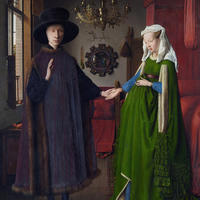More about National Gallery London

Sr. Editor
London's National Gallery is so huge you might need a nap halfway through.
The museum was started in 1824, when the British government got jealous of other countries’ art museums and decided to buy 38 paintings from the estate of art patron John Julius Angerstein. Usually museums start when an existing collection is given to the public. Once the National Gallery's initial collection was put on display however, other collections started rolling in, so, it turns out with benefit of hindsight, the British government made a wise investment up front.
For a long time the collection was housed in Angerstein’s old house at 100 Pall Mall, London and it totally sucked. It was crowded, hot, and at least 90% lamer than the Louvre, which would JUST NOT DO. A new site was founded in 1832 at its current location at Trafalgar Square.
The location was a bit controversial since the area suffered from a lot of pollution and the new building wasn’t even that great. The building could only be one room deep because of other existing buildings and public walkways running through the middle of the building. Everyone hated it. It was even ridiculed before it was finished when the architecture plans were leaked to the Literary Gazette in 1833. The Brits reasoned however, that the location was perfectly situated between the rich and poor areas of London allowing for all walks of life to visit the National Gallery.
Due to a number of large donations, the museum ran out of space, and ended up commandeering several large houses around London to display the collection.
When the artist J. M. W. Turner died, he donated his collection of over 1,000 works to the Gallery. This really put the museum in danger of exploding with art, and a decision was made to create a second museum to take the overflow, in particular the more modern artworks. That museum in now the Tate Britain.
Hop on one of London’s classic double-decker buses via the 9 or 15 heritage routes. The 15 starts at the Tower of London and the 9 starts at Kensington High Street but both end at Trafalgar Square and the National Gallery. The trip is super cool by itself taking you past some of London’s top spots and is majorly convenient, dumping you right on the front steps of the museum.
Featured Content
Here is what Wikipedia says about National Gallery
The National Gallery is an art museum in Trafalgar Square in the City of Westminster, in Central London, England. Founded in 1824, it houses a collection of more than 2,300 paintings dating from the mid-13th century to 1900. The current director of the National Gallery is Gabriele Finaldi.
The National Gallery is an exempt charity, and a non-departmental public body of the Department for Culture, Media and Sport. Its collection belongs to the government on behalf of the British public, and entry to the main collection is free of charge.
Unlike comparable museums in continental Europe, the National Gallery was not formed by nationalising an existing royal or princely art collection. It came into being when the British government bought 38 paintings from the heirs of John Julius Angerstein in 1824. After that initial purchase, the gallery was shaped mainly by its early directors, especially Charles Lock Eastlake, and by private donations, which now account for two-thirds of the collection. The collection is smaller than many European national galleries, but encyclopaedic in scope; most major developments in Western painting "from Giotto to Cézanne" are represented with important works. It used to be claimed that this was one of the few national galleries that had all its works on permanent exhibition, but this is no longer the case.
The present building, the third site to house the National Gallery, was designed by William Wilkins. Building began in 1832 and it opened to the public in 1838. Only the façade onto Trafalgar Square remains essentially unchanged from this time, as the building has been expanded piecemeal throughout its history. Wilkins's building was often criticised for the perceived weaknesses of its design and for its lack of space; the latter problem led to the establishment of the Tate Gallery for British art in 1897. The Sainsbury Wing, a 1991 extension to the west by Robert Venturi and Denise Scott Brown, is a significant example of Postmodernist architecture in Britain.
Check out the full Wikipedia article about National Gallery



















